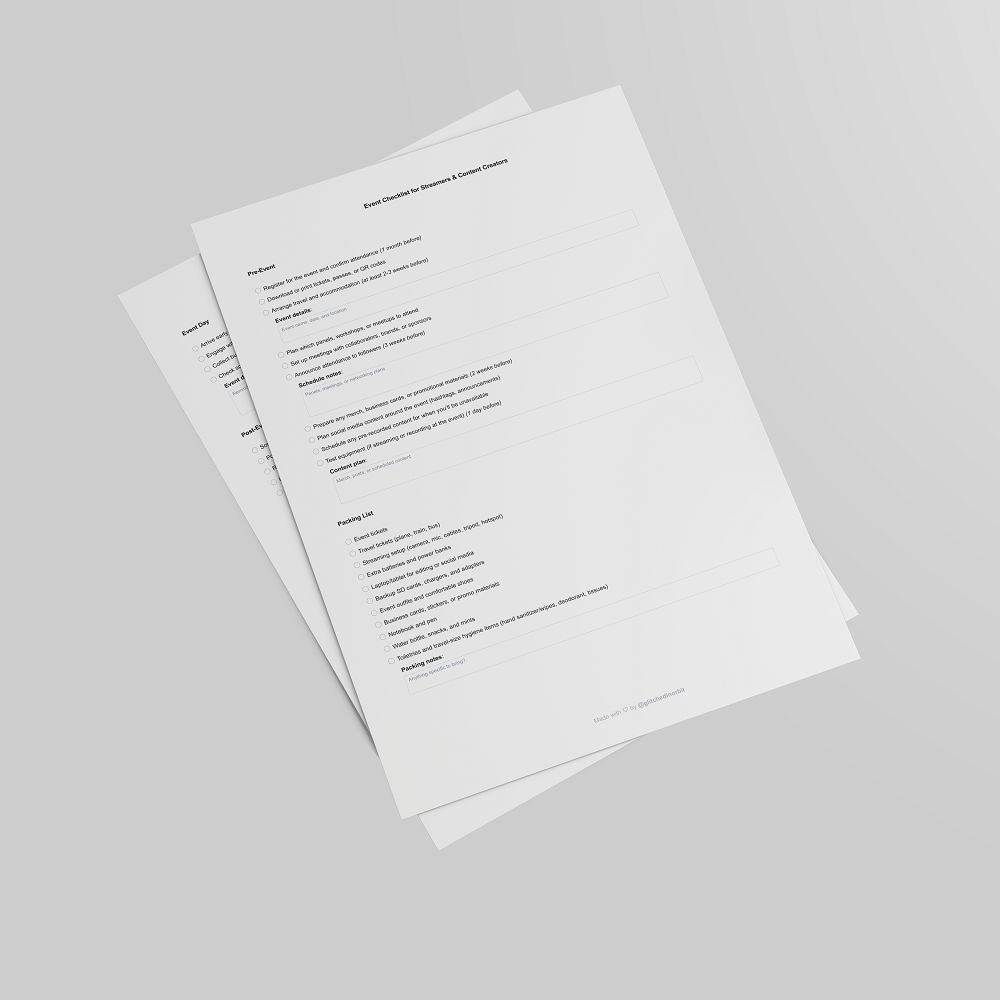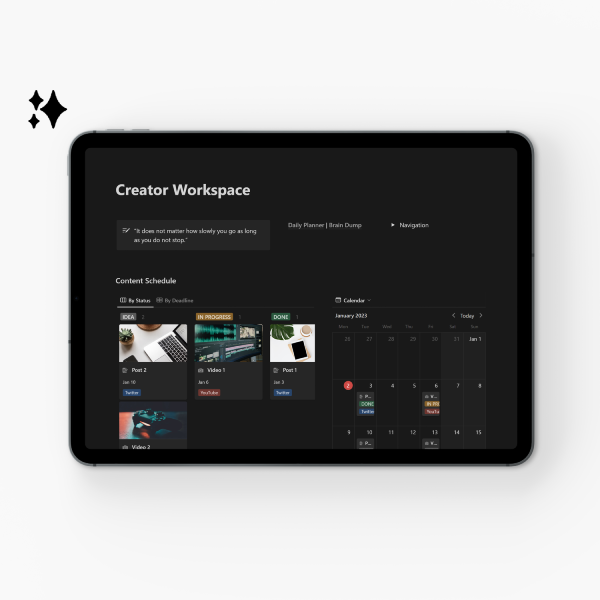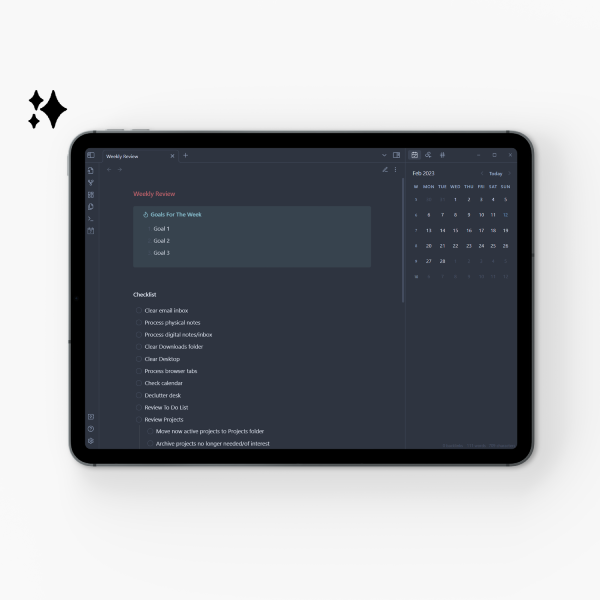Struggling to find balance as a content creator? It can be difficult to draw the line between 'on' and 'off' time. This article lists how you can improve your mental wellbeing while creating content.

Jump to section:
- Introduction
- 1. Do What You Love
- 2. Compare Yourself To Yourself Only
- 3. Diversify Your Content
- 4. Generate Streams Of Passive Income
- 5. Take Good Care Of Yourself
- 6. Do Not Focus On Metrics
- 7. Create The Workflow That Works For You
- To Wrap Up
Introduction
As a creator, the pressure to be ‘on’ all the time can become overwhelming. This can make it difficult to set boundaries and truly take time for yourself.
This guide will give you some actionable tips to take control over your mental wellbeing in the digital space.
All tips are taken from research and personal experience.
Take a deep breath. Let’s hop in.
Disclaimer: this post contains affiliate links, so I may receive a commission if you choose to make a purchase through any of those links.
1. Do What You Love
Okay.
I know it sounds cheesy to start off with this, but hear me out.
Content creation isn’t a ‘get-rich-quick’ scheme. You have to be in it for the long haul.
If you do not pursue what you love or at least enjoy doing, you will eventually burn out. Otherwise, what you’re doing isn’t aligned with your strengths, values, and true self.
Thus, you need to create content in the field that you love.
There’s a Japanese concept called ikigai. This is your ‘purpose in life’ or ‘reason to live’, so to speak.
The Western interpretation, especially in Héctor García’s Ikigai: The Japanese Secret to a Long and Happy Life, is more specific. It encapsulates ikigai as what you love, what you’re good at, what you can be paid for, and what the world needs.
In essence, you found your ikigai if you can find pleasure and satisfaction in what you do and you’re good at it.
But, while the book is a good read, your ikigai doesn’t need to entail a combination or any of these four things per se.
I can highly recommend two books for an authentic Japanese perspective on ikigai. Namely, Ikigai: The Japanese Art of a Meaningful Life by Yukari Mitsuhashi and The Little Book of Ikigai by Ken Mogi.
According to Mogi and Mitsuhashi, you can find your ikigai in a wide range of conditions.
Research has indicated that you are less likely to experience depression and more likely to measure well-being if you have a sense of ikigai. [1] [2] [3]
Invest time in discovering your ikigai.
Don’t let others decide for you what you should do. Your content creation journey comes from where your passions and goals lie.
For example, I love entertaining others, writing and doing academic research, and sharing my experience. Plus, mental health is very important to me. Hence this blog.
This might not be the field where you want to create content in, and that’s okay. Content creation looks different for everyone.
Whatever you do, make sure to provide value to your audience.
You can provide value in different ways, be it educational, entertaining, or otherwise. You need to find what you value and what you wish to share with the world.
Only you can decide what you love doing.
2. Compare Yourself To Yourself Only
It’s very easy to get caught up in comparing yourself to others. It’s happened to me. I would compare myself to other content creators, which lowered the confidence in my abilities.
Worse, it would negatively impact the quality of my own content.
I’d keep overthinking and worrying about what others were creating and how I compared. Eventually, this negative spiral led to burnout.
This is how I got out of the negative comparison spiral:
Focus on what you want to contribute to the world and what you enjoy doing.
Remind yourself that someone else’s success isn’t your failure. Look at the progress you have made over the past few days, weeks, or even years.
It’s easy to forget how far you’ve come, but you can always make time to evaluate.
In the end, you can only compare yourself to yourself, and grow from what you have done and learned the day(s) before.
Success means something different for everyone.
3. Diversify Your Content
When it comes to any type of content creation, exposure is very important.
You want to get your content out there for others to see. I’d assume you do. Otherwise, why are you creating content?
By diversifying your content, you avoid putting all your eggs in one basket. This includes the type of content you create, but also the platform you’re on. Otherwise, you can expect diminishing returns.
I’ve learned this the hard way.
You risk limiting your exposure by only staying on one platform or by only creating one form of content.
That said, you have to find the best content creation platform that works for you and your needs. The same goes for the content itself.
However, do keep balance with diversifying. Every additional platform is extra work. It’s best to stick to 2-4 main platforms.
For example, I currently like to curate content for YouTube, livestream on Twitch, and post on Twitter.
4. Generate Streams Of Passive Income
Passive income is an amazing way to generate income even when you’re not actively working.
This takes the load off of having to be ‘on’ as a creator at all times.
For example, I get income through YouTube ads, Twitch subscriptions, and Ko-fi tips. Now I also have this blog, which includes affiliate links and (non-intrusive) ads in the future.
There are many ways in which you can generate passive income.
They don’t all have to take up a lot of time either.
Passive income ideas
- create an online course
- write an e-book
- start a blog (like me!)
- upload content to YouTube
- create an app
- sell merchandise
- get sponsorships
- affiliate marketing
- ad placement
- subscriptions
This idea list is non-exhaustive, and there are many other ways to generate passive income.
Get creative!
5. Take Good Care Of Yourself
As with all things in life, your endeavors need balance. You have to take care of yourself before you can take care of others - or work-related endeavors.
You’re also more efficient and productive if you take care of yourself. Plus, you can create higher quality content.
It’s a win-win for everyone.
Self care ideas
- find a daily routine that works for you
- prioritize sleep hygiene and a night-time routine
- stay hydrated
- feed your body and soul with nourishing foods
- schedule breaks (I still struggle with this) - set alarms or use the Pomodoro Method
- find ways to decompress, if only for 5 minutes - journal, meditate, exercise, read a book, take a walk in nature, take a hot bath/shower, etc.
Additionally, find ways to manage your energy.
I like to use The Spoon Theory, coined by Christine Miserandino.
It’s a metaphor to describe the amount of energy someone has available for daily tasks. This energy can be physical or mental.
Not everyone has the same amount of energy available. People with a disability, chronic illness, or mental health issues may have less energy to begin with. Compare that to someone who doesn’t have to cope with anything like this.
It’s important to know how much energy you have in a day, and how to manage your energy to get tasks done.
It might look something like this.
Energy regenerates after a nap or a cup of tea, but depletes after spending time in a group of people or doing chores.
For me, it’s been very helpful to make a list of what gives me energy and what drains my energy.
I challenge you to make a list like this as well. If you need any inspiration, think of what you used to love doing as a kid.
6. Do Not Focus On Metrics
Worrying about and overanalyzing metrics led me to burnout on numbers.
I felt like I was never doing well or good enough.
As a content creator it’s easy to become fixated on numbers. Especially as a streamer on Twitch, because you get access to them after every broadcast. They can immediately impact your mood if you let them.
I’d check my streaming analytics after streams to ‘analyze’ how I did, but I’d always feel deflated.
The fact of the matter is that numbers fluctuate, especially during livestreams.
Low(er) viewer count does not, I repeat DOES NOT, necessarily mean you put out bad content. People hop in and out of streams, people go outside, real life happens…
You might also not be discoverable enough. In this case, lack of proper discoverability on the platform itself plays a big role.
Do NOT make the mistake of equating numbers with success or lack thereof.
Keep in mind that there’s always a person behind the number. Don’t lose track of that.
Do occasionally review your metrics.
A good rule of thumb is to review them over a 30 day, 60 day, or 90 day period. This gives you a good reference point for how you performed, and whether you need to pivot or not.
For livestreams specifically, 90 days gives the most accurate depiction of performance.
Instead of worrying about numbers, get creative and elevate the content you have to offer. Test out new concepts, optimize SEO, work on self-growth, etc.
Review your metrics only every once in a while instead of multiple times per week.
Take back a healthier headspace.
7. Create The Workflow That Works For You
There are many ways in which you can create a workflow specialized for you.
Examples could be setting ‘office hours’ to manage your time, creating a to-do list, or setting deadlines for yourself.
The 80/20 Principle: The Secret to Achieving More with Less by Richard Koch has had a great impact on my workflow.
It entails that 20% percent of your time accounts for 80% of results. Vice versa, sometimes 80% of the time you spend accounts for only 20% of results.
Greg McKeown’s Essentialism: The Disciplined Pursuit of Less provided a similar insight.
You can increase your effectiveness simply by identifying what you’re wasting time on and what you should be focusing on instead.
In other words, focus on that which is absolutely essential - or on the 20% that brings 80% of results.
I started combining the 80/20 Principle and Essentialism.
Maybe this works for you too.
It has also helped me to make use of templates or pre-made assets to take the load off of having to start from scratch every single time.
You can look into Ko-fi, Fiverr, or Etsy for this.
Whatever you do, it’s important to adapt a workflow to your needs specifically.
If you need to schedule an afternoon nap to recharge and get your creative juices flowing, do it!
If you need to break larger projects into smaller tasks, do it!
Everyone is different and no one works in the same way.
To Wrap Up
This list has hopefully given you some helpful tips tp take care of you mental wellbeing in the digital creation sphere.
Let me know what you do to find balance as a content creator.
Thanks for reading!
Sources
Fido, Dean, Yasuhiro Kotera, and Kenichi Asano. “English translation and validation of the Ikigai-9 in a UK Sample.” International Journal of Mental Health and Addiction 18 (2019): 1352–1359. https://doi.org/10.1007/s11469-019-00150-w.
Imai, Tadanori, Hisao Osada, and Yoshimitsu Nishimura. “The reliability and validity of a new scale for measuring the concept of Ikigai (Ikigai-9).” Japanese Journal of Public Health 59, no. 7 (2012): 433–439. https://doi.org/10.11236/jph.59.7_433.
Wilkes, Juliet, Gulcan Garip, Yasuhiro Kotera, and Dean Fido. “Can Ikigai Predict Anxiety, Depression, and Well-being?” International Journal of Mental Health and Addiction (2022): 1-13. https://doi.org/10.1007/s11469-022-00764-7.
Recommended Posts

Financial Sustainability Tips For Neurodivergent Streamers (Without Burnout)
Content pacing, energy-based planning, and income strategies for disabled and neurodivergent streamers.
Continue Reading
Rethinking Productivity Advice For Neurodivergent Creators
A neurodivergent-friendly approach to productivity for creators and freelancers, with practical strategies like flexible goals, guilt-free breaks, and self-compassion.
Continue Reading
Protecting Your Privacy As A Streamer
A guide to help streamers protect their privacy online and in-person, including tips for safeguarding finances, address, accounts, and physical...
Continue ReadingRecommended Items

Event Checklist & Emergency Plan
Stay organized for every part of your event experience.
Download Now

